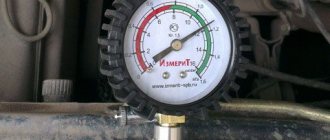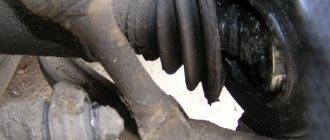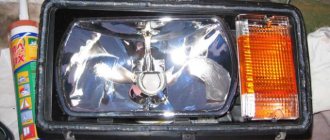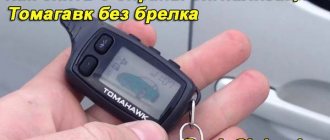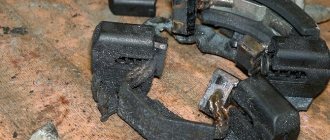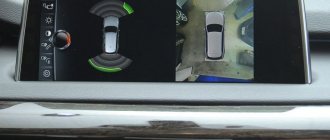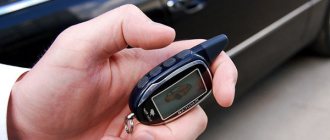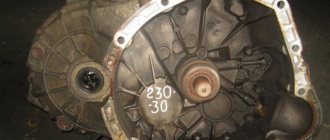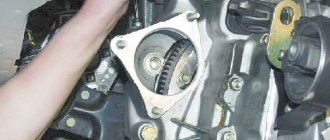The reasons for alarm failure are various. You can simply lose your keychain and not find a replacement for it. In this case, you either contact the service, resorting to the help of professionals, or change everything yourself. If the replacement of the car alarm will be carried out at a service center, choose it responsibly. Often the link between the car owner and the burglar is the service center or its unscrupulous employee. Consult with your friends, read reviews and only then trust your car to strangers.
Before installing a new alarm, you must first dismantle the old one.
How to replace a car alarm
The reasons for alarm failure are various. You can simply lose your keychain and not find a replacement for it. In this case, you either contact the service, resorting to the help of professionals, or change everything yourself. If the replacement of the car alarm will be carried out at a service center, choose it responsibly. Often the link between the car owner and the burglar is the service center or its unscrupulous employee. Consult with your friends, read reviews and only then trust your car to strangers.
Before installing a new alarm, you must first dismantle the old one.
Possible reasons for dismantling a car alarm
There are several reasons when it may be necessary to remove the alarm:
Loss of system functionality. If attempts to repair the alarm are unsuccessful, then all that remains is to remove it from the car.
Incorrect work. If the alarm system malfunctions or has lost some of its functionality, then it can leave the car without protection at a crucial moment. Or even open it without your knowledge. To avoid this, you need to dismantle the failing system.
Purchasing a used car with an already installed alarm system. When buying a car second-hand, the previous owner may still have access to the car or information about its location. He can keep the additional key fob and use it for illegal purposes. Or hide from you the location of secret buttons or a tracking module. To protect your new property from this, you should completely remove the old security system and install a new one.
The old alarm system has insufficient functionality. If you lack the capabilities of your system (for example, it does not have an autostart function or GSM connection), then you will be tempted to replace it. And before installing a new one, you need to carefully dismantle the old one.
Wear and obsolescence. If the security complex is already more than five to seven years old, then its encryption systems in the current conditions are quite easy to crack with code grabbers. The effectiveness of protection is close to zero. To restore its effectiveness, it is recommended to replace the system with a new and up-to-date one. In addition, the appearance of an outdated alarm key fob may be shabby and no longer pleasant to use. This is also a sufficient reason for replacement.
Important! It is not necessary to remove the old alarm before installing a new one; you can simply turn it off. However, the old systems can greatly interfere with the operation of the new one and leave your car unprotected.
Removing the old alarm
For dismantling you will need the following tools:
At the beginning of work, we find the LED and disconnect the wiring from it. It should be located on the dashboard and lead to the alarm control unit. We patiently disconnect the wires from the engine indicator, side lights, stop lights, limit switches, that is, from everything to which you once connected the alarm.
Then we sequentially disconnect from the sensors. We proceed to removing the jack button and siren. To do this, move to the hood. After turning off the alarm, we check the functionality of the car.
Design and principle of operation of car alarms
Like a number of other electronic equipment, a car alarm consists of the following blocks:
- control unit;
- block of input devices;
- block of actuators.
Let's look at the purpose of each block in more detail. Input devices are usually input sensors and a remote control (remote control). The remote control is a key fob. If we consider the standard alarm system, it is made together with the ignition key. Basically, two key fobs are attached to the car, one of which is the main one, the second is a spare one. The key fob is designed to arm and disarm the alarm system. In addition, it is possible to monitor the condition of the vehicle. Depending on the design of the device, using a key fob, you can remotely start not only the engine, but also control electrical equipment, and search for a car in a parking lot.
Any car alarm consists of a control unit, a unit of input devices and a unit of actuators
The key fob and alarm communicate with each other via a radio channel. An important point is the protection of information from possible interception, i.e. it is encoded. It can be static or dynamic. Today, static coding is not used. The dynamic method of encoding information is characterized by a high degree of protection against interception.
The purpose of the input sensors is to perform security functions of a car alarm. When the car is armed, with their help, a number of physical parameters are recorded, which are converted into electrical signals. The main sensors in anti-theft equipment include:
- shock sensor;
- contact sensor;
- tilt sensor;
- volume sensor.
Depending on the design features of the device, this list may be supplemented with other sensors:
- motion sensor;
- broken glass sensor;
- power failure sensor;
- voltage drop sensor.
What is the operating principle of the main sensors? Let's start the review with the shock sensor. With the help of this element, mechanical vibrations are converted into an electrical signal. The design consists of a piezoelectric plate, which begins to vibrate as a result of an impact. At the moment when a certain vibration value is exceeded, light and sound signals are triggered. However, such a sensor is not without drawbacks, which amount to false alarms. Due to the described problem, the standard alarm systems do not have such sensors. The problem is solved by adjusting the highly sensitive elements.
Using a shock sensor (shock sensor), mechanical vibrations are converted into an electrical signal
Protection of the car body is provided by contact sensors:
- limit switches;
- push-button switches;
- microswitches.
The purpose of the tilt sensor is to trigger when the car is tilted, which usually happens when loading the car onto a tow truck or when trying to jack it up. This element is an acceleration sensor. Thanks to its setting, it is impossible to react to the position of the body in natural conditions, for example, during strong winds, low tire pressure or subsidence of the ground. As for the volume sensor, it is used to record any movements inside the car. Such elements are sensory devices. The most popular sensors include microwave and ultrasonic.
The microwave sensor is designed to work with radio waves in the centimeter range. This type is two-zone. In addition to the fact that it detects movement inside the cabin, it helps to record movements in the immediate vicinity. An ultrasonic sensor consists of an emitter and a receiver. When the doors and windows of a car are closed, ultrasonic waves are reflected from the surface of the passenger compartment. This creates a constant wave signal that is analyzed by the receiver. At the moment of penetration into the car, the nature of the waves changes, as a result of which the security device is activated.
An important role is played by the electronic control unit, which processes input signals from the sensors listed above, as well as from the key fob. After the signals arrive, a control signal is generated to the actuators. The design features of the standard alarm system are such that the control unit is not installed. Therefore, the power of blocks of other systems, for example, central locking (central locking), is used.
The alarm control unit processes incoming signals from the key fob and various sensors
The actuators of anti-theft equipment include a siren and light indication. There are designs of the systems under consideration with an immobilizer. In such devices, in addition to those listed, a blocking relay is added. The interaction of the security system with other devices occurs through the lighting system, central locking, starting system, and electric windows.
Both passive and active sirens can be installed in car alarms. The active alarm system has a built-in battery that ensures uninterrupted operation of the device when the vehicle's power is turned off. There are also modern alarms equipped with a special module that provides control and status monitoring via a cellular communication channel. You need to know about all of the above in order to choose the right anti-theft equipment and install it yourself.
Alarm installation
Having coped with the dismantling of the faulty signaling, we proceed to installing a new kit. We remind you that this kit should include:
Important! Before purchasing a new alarm system, be sure to check the availability of all necessary components, instructions for activation and use, and warranties.
Tool preparation
For self-installation, you need to prepare the necessary tools and know how to use a voltage measuring device:
Now you can start installation.
Installing a new alarm
Behind the dashboard you will find ample space to mount a center unit and a special jack lever. You should have enough space to quickly access it.
Next, you need to connect the wires to the engine status indicator, side lights, stop and turn signals. We also stretch the wires to the hood to connect to the siren.
All exposed sections of wires must be wrapped with electrical tape. Make sure that they do not come into contact with exposed metal parts of the body.
We install a siren under the hood. The choice of location must be justified. The main condition is the absence of moisture and distance from those parts of the engine that can become very hot. In order to avoid moisture getting into the siren, it is necessary to point it downwards. We connect the wire from the siren to the battery. Now that the installation is complete, let's check.
If problems arise, first check that the electrical connection is correct. Program the key fob and alarm system strictly in accordance with the instructions. Program both key fobs at once.
Price for withdrawal in the service
If it is necessary to dismantle the security system, a reasonable option would be to contact a specialized service center. However, you may be surprised that the price of such work will be close to the price of installing a new one and will be at least 2,000 rubles. The work will be more difficult and more expensive if:
- alarm with feedback;
- equipped with autostart;
- there are additional engine locks;
- there are GSM or satellite modules;
- the system is combined with an immobilizer;
- information from the door switches is taken not from the CAN bus, but through separate non-standard electrical wiring;
- Additional sensors are installed (tilt, volume, motion).
For each of these points, you can safely add 500-1000 rubles to the price of the work. Especially if it will be necessary to search for and remove non-factory wiring.
Important! Unskilled garage repairmen may charge a small fee for this work. However, the quality of their work leaves much to be desired. They may not only not complete the job, but also damage the car.
Possible difficulties during replacement
We started talking about the fact that the “old” and “new” blocks should not differ in the wiring of the main connector. This refers to the connector that has the most contacts (they are arranged in 2 rows). Additional contacts are outputs for central locking, auto start, as well as sensor connectors. These contacts can be positioned as you please, and when connecting them, you simply solder the cord to the new plug.
Although, it will be even better if everything matches (the need to solder is bad).
Programming a new alarm
It would seem that if a new unit is successfully connected, all that remains is to register the key fobs in the memory of this unit. But, take your time - without correctly setting the parameters, the alarm will not work. The combination “correct meaning” must mean “the same as it was before.”
For example, the duration of the pulse for opening and closing locks must be selected as accurately as possible (otherwise, the locks simply will not close). The same applies to other parameters and functions.
What exactly do you need to ask?
We have already named one of the important parameters that must be configured. Let's list all these parameters below:
What is mentioned here is the minimum set, that is, in reality the list may be even larger.
The functions include, for example, automatic activation of the security mode, horn operation algorithm and others.
It is important to know that this adjustment must always be made when you replace an old unit with a new one.
This is true even if the unit is the same model as the one installed previously. “Default” is always set to values that are not suitable for anyone. So, taking a booklet from the “old” signaling system, find the notes made by the operator earlier. Otherwise, it will be almost impossible to configure.
Example of replacing block B9 with A91
The car had a Starline B9 alarm unit installed. Then it was replaced with the “A91” block, changing at the same time the transceiver module (for B9 and A91 these modules are incompatible). Next, it was necessary to set the alarm parameters “from scratch”, using the data recorded by the installer of the “old” unit. For this, according to the official instructions, the programming mode was activated.
While in this mode, you need to select a function or parameter number (from 1 to 15) by pressing the Valet button the appropriate number of times. As a result, the key fob display will begin to display the parameter number, as well as its value.
Each function or parameter is coded with a number (this is true not only for Starline). The key fob usually displays this: “1 –> 1”, “2 –> 4” and so on. That is, the option numbered “1” has the value “1”, the second option has the value “4”... From the instructions it is easy to find out the decoding of these numbers:
Having looked at the specified table, as a rule, there are no questions left. We need a double closing impulse - set the value to “3”. And if the result is not satisfactory, we say “goodbye” to the new block.
Probably everyone understands that we would have to program the signaling in exactly the same way if we changed “A91” to “A91”.
In principle, everything is simple here: we go into programming mode and look through all the options one by one (from 1 to 15). The parameter values must be known, that is, notes from the documentation for the “old” block are needed. If there is no such information, you will have to “sort through” the values, which is very inconvenient and time-consuming.
Modular alarms
Modularity is one of the main vectors of development of modern security systems. As an example, we can cite StarLine alarms, starting from the third generation (now, for reference, the sixth is being produced). Their central unit has several pre-provisioned slots for expansion modules, which no longer need to be secured separately by running wires to the central unit. This provides an interesting opportunity to upgrade a previously purchased system on a limited budget.
For example, you bought an inexpensive StarLine system several years ago. In the cheapest configuration it does not have expansion modules. In the future, you can install an interface module on it that matches the design of the machine: • If only one CAN bus can be used for connection on the machine, then you can use any of the proposed modules, the most advantageous, of course, is the simplest one - 2CAN. • Connection to two CAN buses (low-speed for controlling light and central locking, high-speed for receiving engine information) CAN modules offer 2CAN, 2CAN+LIN, 2CAN+2LIN. • If for operation you need to connect to the LIN bus (usually to control the central locking, for example, on VAZ cars), then most often the 2CAN+LIN module is used, less often - 2CAN+2LIN (if two LIN buses are used).
Which security system to choose?
Of the companies on the market, it is definitely worth recommending two domestic ones and the St. Petersburg-based StarLine. We wrote about them in more detail here. Their systems are structurally reliable and currently maintain cryptographic strength, that is, they cannot be hacked by code grabbers**. And, given the variety of systems they offer, from budget to luxury, you can find a suitable system for any car.
For example, you can install StarLine A93 ECO on a budget car - this system with auto start will cost only 7,700 rubles, which is not much for a high-quality alarm system. In the future, it can be retrofitted with a GSM module, or you can immediately take the alarm in the StarLine A93 GSM version. Physically, such an alarm system will be outdated for a very long time (the element base and circuitry are at a high level), and all functional updates in it are available after a simple flashing.
*Jammers are devices that jam the radio air, preventing the alarm from transmitting an alarm signal. **Code grabber allows you to disarm the system, simulating the operation of a standard radio key fob.
Source
Possible consequences of deletion
After completing the work poorly, the following problems may arise:
Short circuits and blown fuses. Most likely this occurs either due to incorrect restoration of the wiring, or due to poor-quality insulation of the abandoned alarm wiring.
The engine does not start. Most often this happens if the system had an autorun function. Without restoring the standard wiring, but simply removing the elements responsible for autostart, the signal to start the engine will physically not be able to reach its destination. Some installers also use their own engine locking methods and these can be difficult to detect.
Malfunction of individual vehicle systems. Inoperability of the door lock drive, horn, and lighting equipment is most often caused by improper restoration of the wiring.
